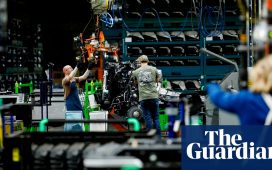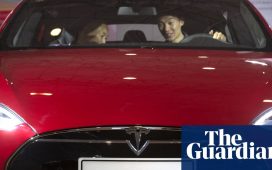The US labor movement is having a moment amid some recent big union contract wins, surges in strikes, historic union election wins at aggressively anti-union corporations, and a presidential administration that touts itself as the “most pro-union in history”.
Last week, the United Auto Workers reached a historic tentative agreement with Ford that includes 25% wage gains, then shortly after reached an agreement with Stellantis and General Motors. The UAW has called on other unions to time their contract expirations with 1 May to collectively pressure employers simultaneously, with the next UAW contracts at the Big 3 set to expire on 1 May 2028.
Other unions have also won historic contract gains this year at large employers such as UPS and Hollywood studios for TV and film writers.
But labor in the US is still facing significant obstacles and challenges in transforming the popular culture shift into gains against a backdrop of decades of union decline, worsening wealth inequality, and broken labor laws where employers violate labor laws with impunity and try to delay and bust union organizing campaigns.
Unionized workers have been framing recent surges in strikes for new contracts around corporate greed, exorbitant profits and soaring executive pay, leveraging a tight labor market and a growing public shift in support of the US labor movement.
So far 2023 has seen a significant influx in work stoppages, with employers experiencing the largest loss of labor hours to work stoppages in at least 23 years, around 11m labor hours from January to September 2023, according to the Bureau of Labor Statistics.
The Cornell University Labor Action Tracker recorded 69 strikes in September 2023, involving 214,300 workers. Some 11,000 Hollywood television and film writers recently reached a historic deal after five months on strike.
“While the business has boomed, and studios have collected almost $30bn in annual profits, writer pay has gone down,” Laura Blum-Smith, the director of research and public policy at WGA West, said in April.
The Screen Actors Guild, which represents over 150,000 actors, has been on strike since July 2023.
The Good Fight star Christine Baranski said during a strike rally in July: “If this industry can generate millions, hundreds of millions, in compensation for those at the top, it can afford to share the wealth.”
Over 75,000 healthcare workers walked out on a three-day strike from 4 October to 7 October, the largest healthcare strike in US history and shortly won a new contract following the strike.
“The executives that are making millions of dollars aren’t thinking about anyone else but their own profit and their own increasing wages and not thinking about the rest of us,” Jeffrey Melara, a Kaiser Permanente worker in California, said in the days ahead of the strike.
But it is the strike that hit the US car industry that has created the most headlines and impact.
The Big 3 automakers, Ford, General Motors and Stellantis, made $250bn in profits from 2013 to 2022, an increase in 92% while average auto worker wages dropped 19.3% during the same period. Their three CEOS have received about $1bn in compensation since 2010.
Andy Davis, an assembler at Allison Transmission in Indianapolis, Indiana, and UAW Local 933 second vice-president, said the recent strikes and broad fight by autoworkers is a push to restore the upward mobility and security that has dissipated as a worker in a highly profitable industry.
“America sees our UAW jobs as icons of success and stability for the average and ordinary,” said Davis. “That’s exactly what we’re trying to get back to.”
According to the National Labor Relations Board, union petitions increased 3% in fiscal year 2023 compared to 2022, with 2022 seeing a 53% increase in union election petitions from the previous year. During the same period, the NLRB’s field offices saw a 10% increase in unfair labor practice charges, from a 19% increase in 2022.
The NLRB has noted the agency remains severely understaffed and underfunded amid rises in caseloads, with field office staff being cut by 50% in the past two decades.
Meanwhile, labor law reform efforts to improve worker protections to organize unions such as the Pro Act have stalled in Congress, with little to no support from the Republican party despite public support for unions bridging across partisan lines.
US union membership declined to 10.1% in 2022 from 10.3% in 2021, the lowest on record according to the Bureau of Labor Statistics. Although the number of workers belonging to unions increased by 273,000 workers to 14.3 million in 2022, the total number of workers in the US workforce grew by 5.3 million, resulting in the drop in union density.
While national headlines suggest there is a wave of union wins across the US, wide variations persist in unionization rates based on workforces and geography.
Some 33% of public sector workers are union members, compared with 6% of private sector workers. Hawaii has the highest union density in the US, with 21.9% of the workforce affiliated as members of unions, compared with the lowest union density in South Carolina at 1.7%.
These wide variations in union density by state have significant economic impacts. A December 2021 report by the Economic Policy Institute found on average the 17 states with the highest union densities have higher state minimum wages, higher median annual incomes, higher unemployment insurance recipiency rates, lower uninsured populations, and are more likely to have state laws such as paid sick leave and paid family and medical leave.
Union membership in the US soared in the 1930s amid industrial unrest and the Great Depression, spurring union density rates of over 30% in the wake of second world war, but gradually began decreasing in the 1960s only to sharply decline in the 1980s and the following decades.
The labor movement’s rise in the US incited well-funded anti-union efforts, propped up by a multimillion-dollar anti-union consultant industry and corporations that are currently fighting union campaigns despite numerous violations and rulings against them at the National Labor Relations Board. They include Amazon, Starbucks, REI, Trader Joe’s, Apple and Chipotle – big employers who have vigorously fought off union drives and efforts for workers to secure a first union contract.
“Management and employers have captured the labor law terrain and this has been true for quite a while, so that they are extremely effective at blocking unionization efforts and diminishing the power of already organized workers,” said Ruth Milkman, chair of the labor studies department at CUNY School of Labor and Urban Studies. “Until there’s some kind of overhauling of US labor law, it’s hard to see how that long-term decline is going to get turned around. Because what we’re seeing in the new organizing is blockages at every turn.”
Milkman explained that previous upswings in unionization in the US have historically come in large waves, but that the increases in strikes, union organizing among young workers especially and increases in public support for the labor movement have yet to occur on a big enough scale to reverse the long trend of union density decline in the US.
But the desire among workers for unionization is there as numerous polls have reported record favorability, especially among young people, for labor unions. Polling has shown that an increasing number of workers would join a union if they could – far higher rates of favorability than the low proportions of workers in the US who are currently unionized.
“The new organizing is happening, the attitudes, pro-union views, led by a new generation that was often dismissed as apolitical,” added Milkman. “This whole political generation that has only come to being in the last decade or so, they’re very eager to do this and they are running up against a brick wall in a lot of cases, but I don’t think they’re going to stop.”
Ken Jacobs, chair of the University of California Berkeley Center for Labor Research, cited some of the positive rulings to come out of the NLRB under the Biden administration aimed at improving workers’ protections to organize under the National Labor Relations Act amid not only at increases in union election petitions, but win rates for unions as well.
“The win rate has to be turned into gaining collective bargaining agreements” said Jacobs. “There won’t be a change in labor law unless large numbers of workers are in motion demanding unions, and that won’t happen without a large investment in organizing.”
From the Red for Ed teachers’ strike wave in 2018 and 2019 to the uptick in worker organizing both in and out of unionization efforts through the Covid-19 pandemic, Jacobs noted workers being able to raise public awareness and see a ground swelling of support have helped inspire this cultural shift to viewing unions favorably.
“I think we have seen a big cultural shift around unions,” concluded Jacobs. “I don’t think we have in any time in history seen examples that have an important effect on the balance of power between workers and capital happen without very significant pressure from below with massive engagement of workers.”











